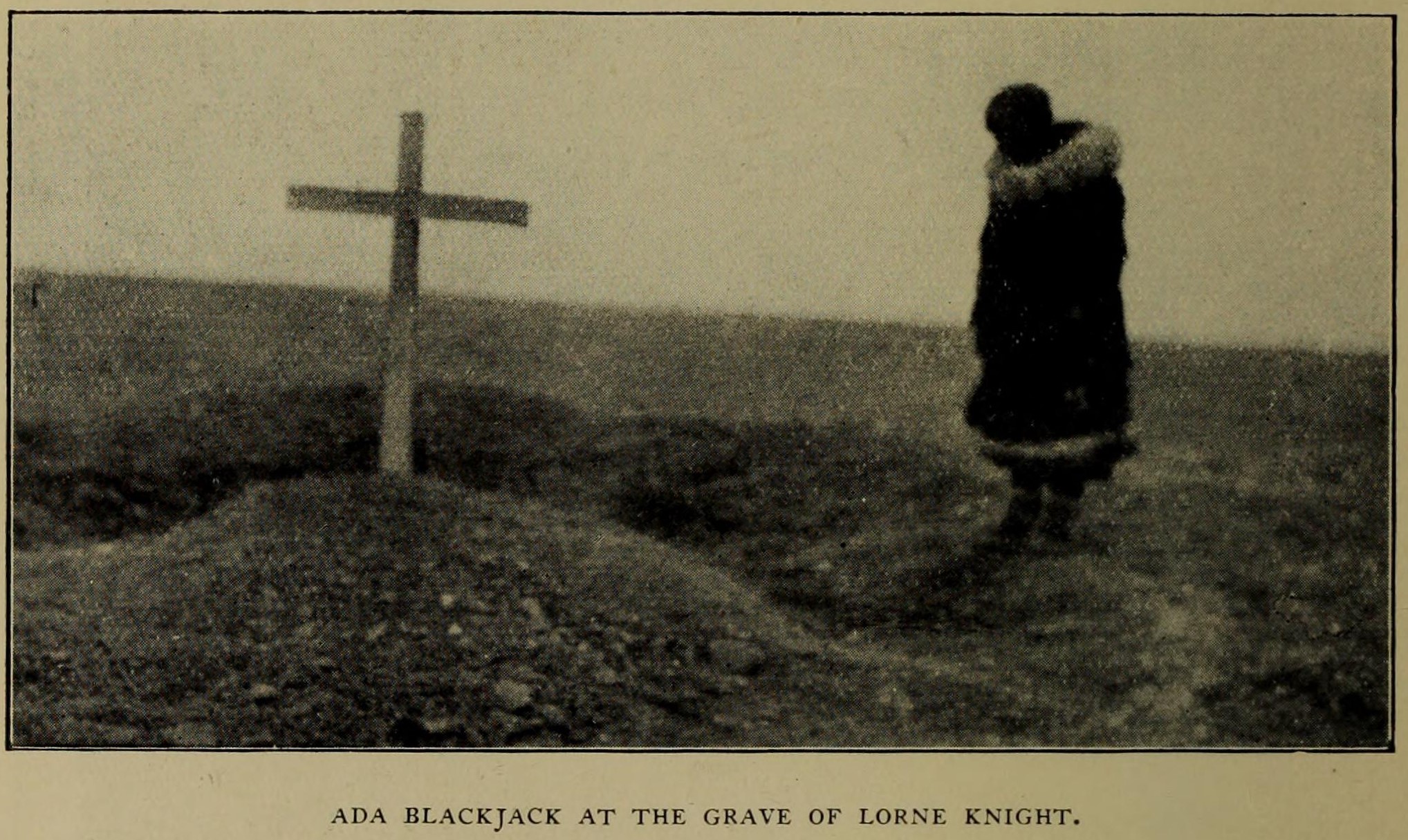Ada Blackjack: Two Years Alone on the Frozen Edge of the World
Imagine being all alone on a frozen island in the Arctic, with no one to help you and barely any food left. Now imagine doing that for two whole years. That's exactly what happened to Ada Blackjack, an Alaska Native woman who became known as the "female Robinson Crusoe" after her incredible story of survival.
Our story begins in 1898 in a small village called Spruce Creek, near Nome, Alaska. That's where Ada Delutuk was born. Ada was an Iñupiat woman, which means she belonged to a group of Alaska Native people who have lived in the Arctic regions for thousands of years.
Life wasn't easy for young Ada. When she was just eight years old, she was sent to a Methodist school in Nome. There, she learned to speak English and was taught how to sew and cook in the American style. But after three years, Ada had to leave school to help take care of her sick mother. As a young woman, Ada married and had three children. Sadly, two of her babies died, and her marriage ended. She was left alone to care for her young son, Bennett, who was very sick with tuberculosis. Ada was desperate to find a way to pay for his medical treatment.
In 1921, when Ada was 23 years old, she heard about a job that seemed like the answer to her prayers. An explorer named Vilhjalmur Stefansson was looking for a seamstress to join an expedition to a remote Arctic-island called Wrangel Island. The job would pay $50 a month, which was a lot of money back then. Ada was hesitant at first. She had never been on a ship before and didn't know much about Arctic expeditions. But she needed the money for Bennett's treatment, so she decided to take the job. She left her son in the care of others, hoping to return with enough money to help him get better.
On September 9, 1921, Ada set sail from Nome with four men: three Americans - Lorne Knight, Milton Galle, and Fred Maurer, and a Canadian named Allan Crawford. Their goal was to claim Wrangel Island for Britain. The island is about 85 miles off the coast of Siberia, surrounded by the icy waters of the Arctic Ocean.
When they arrived on Wrangel Island, the group built a small cabin to live in. Ada's job was to cook, clean, and make and repair clothes for the men. At first, things seemed to be going well. They hunted for food and explored the island. But as winter approached, problems began to arise. The supply ship they were expecting never arrived. Food started to run low, and the men began to get sick with scurvy, a disease caused by not having enough vitamin C.
By January 1923, things had gotten much worse. Three of the men - Crawford, Maurer, and Galle - decided to leave the island to try to get help. They set off across the ice, but they were never seen again. This left Ada alone with Lorne Knight, who was very sick with scurvy. Ada took care of him as best she could, but sadly, he died in June 1923. Now, Ada was completely alone on the island. She had to face her fears and learn to survive by herself in one of the harshest environments on Earth.
Ada knew that if she wanted to live, she had to be brave and resourceful. She taught herself how to set traps to catch foxes for food and fur. She learned to shoot a gun so she could hunt for seals and birds. She even figured out how to chase away polar bears that came too close to her camp. Every day was a struggle. Ada had to constantly search for food and firewood. She had to repair the cabin to keep out the bitter cold winds. All the while, she was battling loneliness and the fear that she might never be rescued.
But Ada didn't give up. She kept a journal where she wrote about her daily life and her hopes of being saved. She also talked to her son's picture every day, which helped her stay strong.
For almost two years, Ada lived alone on Wrangel Island. Then, on August 19, 1923, a ship appeared on the horizon. It was the schooner Donaldson, sent by Stefansson to check on the expedition. When the crew found Ada, they were amazed. Not only had she survived, but she had managed to keep herself healthy and even gained weight. She had collected 14 fox pelts and had kept all the expedition's records safe.
The news of Ada's survival spread quickly. Newspapers called her the "female Robinson Crusoe" and praised her courage and resourcefulness. She had done what many thought was impossible – surviving alone in the Arctic for so long. When Ada returned to Alaska, she was reunited with her son Bennett. She used the money she had earned to pay for his medical treatment, just as she had hoped. Bennett's health improved, and he was eventually cured of tuberculosis.
Ada's story made her famous for a while. People were fascinated by her survival tale. But Ada was a quiet person who didn't like all the attention. She went back to her normal life, got married again, and had another son.
Despite her incredible experience, Ada faced challenges when she returned home. Some people didn't believe her story, and others tried to take advantage of her fame. The families of the men who died on the expedition even blamed her for not doing more to save them, which wasn't fair at all.
As the years went by, Ada's story was largely forgotten by the public. She lived a quiet life in Alaska, working as a seamstress and taking care of her family. She rarely talked about her time on Wrangel Island. In her later years, Ada moved to Palmer, Alaska, where she lived until she passed away in 1983 at the age of 85. Although she didn't seek the spotlight, those who knew her remembered her as a strong, kind, and humble woman.
Today, Ada Blackjack is remembered as one of the most remarkable Arctic survivors in history. Her story teaches us about the strength of the human spirit and the will to survive against all odds. Ada's experience also sheds light on the often-overlooked contributions of Indigenous people, especially women, in Arctic exploration. Her knowledge of traditional Iñupiat skills, combined with what she learned from Western education, helped her survive in conditions impossible to others.
Some interesting facts about Ada's story:
• The temperature on Wrangel Island could drop to -50°F (-45°C) in winter.
• Ada had to deal with 24-hour darkness during the Arctic winter months.
• She learned to build and repair her own traps and even made her own hunting clothing.
• Ada kept the expedition's scientific instruments working and took regular weather readings.
• When rescued, she had managed to save most of the expedition's equipment and records.
Ada Blackjack's story reminds us that ordinary people can do extraordinary things when faced with extreme challenges. She didn't set out to be a hero or an explorer. She was a mother trying to save her son, and in doing so, she became one of the most incredible Arctic survivors in history. Her tale continues to inspire people today, showing us the power of perseverance, adaptability, and hope. Ada Blackjack proved that even in the harshest conditions, with determination and resourcefulness, survival is possible.
As we remember Ada's story, we're reminded of the strength that lies within each of us. We may never face the extreme challenges that Ada did, but her experience teaches us that we're often capable of much more than we realize. Ada Blackjack, the reluctant heroine of Wrangel Island, will always be remembered as a symbol of human resilience and the extraordinary will to survive.
Did Ada Blackjack's incredible survival story inspire you? We'd love to hear your thoughts! Please take a moment to like this article if you found it interesting. Share your reactions or any similar stories of resilience you know in the comments below. And if you think others would enjoy learning about this remarkable woman, don't hesitate to share this article with your friends and family. Your engagement helps us continue to bring fascinating historical tales to light. Thank you for reading!











